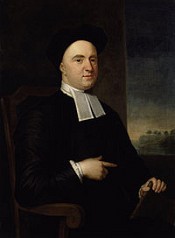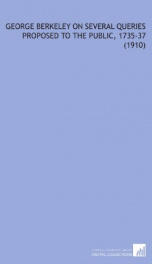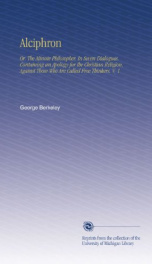Berkeley George

George Berkeley (pronounced /ˈbɑrkli/) (12 March 1685 – 14 January 1753), also known as Bishop Berkeley, was an Anglo-Irish philosopher whose primary achievement was the advancement of a theory he called "immaterialism" (later referred to as "subjective idealism" by others). This theory contends that individuals can only know directly sensations and ideas of objects, not abstractions such as "matter". The theory also contends that ideas are dependent upon being perceived by minds for their very existence, a belief that became immortalized in the dictum, "Esse est percipi" ("To be is to be perceived"). His most widely-read works are A Treatise Concerning the Principles of Human Knowledge (1710) and Three Dialogues between Hylas and Philonous (1713), in which the characters Philonous and Hylas represent Berkeley himself and his older contemporary John Locke. In 1734, he published The Analyst, a critique of the foundations of infinitesimal calculus, which was influential in the development of mathematics. Berkeley was born at his family home, Dysart Castle, near Thomastown, County Kilkenny, Ireland, the eldest son of William Berkeley, a cadet of the noble family of Berkeley. He was educated at Kilkenny College and attended Trinity College, Dublin, completing a Master's degree in 1707. He remained at Trinity College after completion of his degree as a tutor and Greek lecturer. His earliest publication was a mathematical one but the first which brought him into notice was his Essay towards a New Theory of Vision, first published in 1709. In the essay, Berkeley examined visual distance, magnitude, position and problems of sight and touch. Though giving rise to much controversy at the time, its conclusions are now accepted as an established part of the theory of optics. The next publication to appear was the Treatise concerning the Principles of Human Knowledge in 1710, which was followed in 1713 by Three Dialogues between Hylas and Philonous, in which he propounded his system of philosophy, the leading principle of which is that the world as represented to our senses depends for its existence, as such, on being perceived. Of this theory, the Principles gives the exposition and the Dialogues the defence. One of his main objectives was to combat the prevailing materialism of the time. The theory was largely received with ridicule; while even those, such as Samuel Clarke and William Whiston, who did acknowledge his "extraordinary genius," were nevertheless convinced that his first principles were false. Shortly afterwards, Berkeley visited England, and was received into the circle of Addison, Pope and Steele. In the period between 1714 and 1720, he interspersed his academic endeavours with periods of extensive travel in Europe, including one of the most extensive Grand Tours of the length and breadth of Italy ever undertaken. In 1721, he took Holy Orders in the Church of Ireland, earning his doctorate in divinity, and once again chose to remain at Trinity College Dublin, lecturing this time in Divinity and in Hebrew. In 1724, he was made Dean of Derry. In 1725, he formed the project of founding a college in Bermuda for training ministers for the colonies, and missionaries to the Indians, in pursuit of which he gave up his deanery with its income of £1100. In 1728, he married Anne Forster, daughter of the Lord Chief Justice of Ireland. He then went to America on a salary of £100. He landed near Newport, Rhode Island, where he bought a plantation – the famous "Whitehall." He lived at the plantation while he waited for funds for his college to arrive. The funds, however, were not forthcoming and in 1732 he returned to London. While living on London's Saville Street, he took part in the efforts to create a home for the city's abandoned children. The Foundling Hospital was founded by Royal Charter in 1739 and Berkeley is listed as one of its original governors. In 1734, he was appointed Bishop of Cloyne in Ireland. Soon afterwards, he published Alciphron, or The Minute Philosopher, directed against both Shaftesbury and Bernard de Mandeville; and in 1735–37 The Querist. His last two publications were Siris: Philosophical reflexions and inquiries concerning the virtues of tar-water, and divers other subjects connected together and arising from one another (1744) and Further Thoughts on Tar-water (1752). Pine tar is an effective antiseptic and disinfectant when applied to cuts on the skin, but Berkeley argued for the use of pine tar as a broad panacea for disease in general. It is said that his 1744 book on the medical benefits of pine tar was his best-selling book in his lifetime.[1] He remained at Cloyne until 1752, when he retired and went to Oxford to live with his son. He died soon afterward and was buried in Christ Church Cathedral, Oxford. His affectionate disposition and genial manners made him much loved and held in warm regard by many of his contemporaries. As a young man, Berkeley theorized that individuals cannot know if an object is; they can only know if an object is perceived by a mind. He stated that individuals cannot think or talk about an object's being, but rather think or talk about an object's being perceived by someone. That is, individuals cannot know any "real" object or matter "behind" the object as they perceive it, which "causes" their perceptions. He thus concluded that all that individuals know about an object is their perception of it. Under his theory, the object a person perceives is the only object that the person knows and experiences. If individuals need to speak at all of the "real" or "material" object, the latter in particular being a confused term that Berkeley sought to dispose of, it is this perceived object to which all such names should exclusively refer. This raises the question whether this perceived object is "objective" in the sense of being "the same" for fellow humans. In fact, is the concept of "other" human beings, beyond an individual's perception of them, valid? Berkeley argued that since an individual experiences other humans in the way they speak to him —something which is not originating from any activity of his own —and since he learns that their view of the world is consistent with his, he can believe in their existence and in the world being identical or similar for everyone. From this it follows that: Theologically, one consequence of Berkeley's views is that they require God to be present as an immediate cause of all our experiences. God is not the distant engineer of Newtonian machinery that in the fullness of time led to the growth of a tree in the university quadrangle. Rather, my perception of the tree is an idea that God's mind has produced in mine, and the tree continues to exist in the quadrangle when "nobody" is there, simply because God is an infinite mind that perceives all. The philosophy of David Hume concerning causality and objectivity is an elaboration of another aspect of Berkeley's philosophy. As Berkeley's thought progressed, his works took on a more Platonic character: Siris, in particular, displays an interest in highly abstruse and speculative metaphysics which is not to be found in the earlier works. However, A.A. Luce, the most eminent Berkeley scholar of the twentieth century, constantly stressed the continuity of Berkeley's philosophy. The fact that Berkeley returned to his major works throughout his life, issuing revised editions with only minor changes, also counts against any theory that attributes to him a significant volte-face. Over a century later Berkeley's thought experiment was summarized in a limerick by Ronald Knox and an anonymous reply: In reference to Berkeley's philosophy, Dr. Samuel Johnson kicked a heavy stone and exclaimed, "I refute it thus!" A philosophical empiricist might reply that the only thing that Dr. Johnson knew about the stone was what he saw with his eyes, felt with his foot, and heard with his ears. That is, the existence of the stone consisted exclusively of Dr. Johnson's perceptions. What the stone really consisted of (given that such a question can in fact be asked sensibly) could be entirely different in construction to what was perceived - it existed, ultimately, as an idea in his mind, nothing more and nothing less. John Locke (Berkeley's predecessor) states that we define an object by its primary and secondary qualities. He takes heat as an example of a secondary quality. If you put one hand in a bucket of cold water, and the other hand in a bucket of warm water, then put both hands in a bucket of lukewarm water, one of your hands is going to tell you that the water is cold and the other that the water is hot. Locke says that since two different objects (both your hands) perceive the water to be hot and cold, then the heat is not a quality of the water. While Locke used this argument to distinguish primary from secondary qualities, Berkeley extends it to cover primary qualities in the same way. For example, he says that size is not a quality of an object because the size of the object depends on the distance between the observer and the object, or the size of observer. Since an object is a different size to different observers, then size is not a quality of the object. Berkeley refutes shape with a similar argument and then asks: if neither primary qualities nor secondary qualities are of the object, then how can we say that there is anything more than the qualities we observe? Berkeley's Treatise Concerning the Principles of Human Knowledge was published three years before the publication of Arthur Collier's Clavis Universalis, which made assertions similar to those of Berkeley's. However, there seemed to have been no influence or communication between the two writers. German philosopher Arthur Schopenhauer once wrote of him: "Berkeley was, therefore, the first to treat the subjective starting-point really seriously and to demonstrate irrefutably its absolute necessity. He is the father of idealism…"[2]. In addition to his contributions to philosophy, Bishop Berkeley was also very influential in the development of mathematics, although in a rather indirect sense. In 1734, he published The Analyst, subtitled A DISCOURSE Addressed to an Infidel Mathematician. The infidel mathematician in question is believed to have been either Edmond Halley, or Isaac Newton himself, although if to the latter, the discourse would then have been posthumously addressed, as Newton died in 1727. The Analyst represented a direct attack on the foundations and principles of calculus and, in particular, the notion of fluxion or infinitesimal change, which Newton and Leibniz had used to develop the calculus.
do you like this author?
What readers are saying
What do you think? Write your own comment on this book!
write a commentWhat readers are saying
What do you think? Write your own comment on this author!
write a commentBook list

the principles of human knowledge a treatise on the nature of material substan
Series:
Unknown
Year:
Unknown
Raiting:
4.5/5
Show more
add to favoritesadd In favorites

the danger of violent innovation in the state exemplified from the reigns of the
Series:
Unknown
Year:
Unknown
Raiting:
3/5
Show more
add to favoritesadd In favorites
Book list

the principles of human knowledge a treatise on the nature of material substan
Series:
Unknown
Year:
Unknown
Raiting:
4.5/5
Show more
add to favoritesadd In favorites

the danger of violent innovation in the state exemplified from the reigns of the
Series:
Unknown
Year:
Unknown
Raiting:
3/5
Show more
add to favoritesadd In favorites

the analyst or a discourse addressed to an infidel mathematician wherein it i
Series:
Unknown
Year:
Unknown
Raiting:
4.5/5
Show more
add to favoritesadd In favorites

siris a chain of philosophical reflexions and inquiries concerning the virtues
Series:
Unknown
Year:
Unknown
Raiting:
3.5/5
Show more
add to favoritesadd In favorites

selections from berkeley with an introduction and notes
Series:
Unknown
Year:
Unknown
Raiting:
3.5/5
This scarce antiquarian book is included in our special Legacy Reprint Series. In the interest of creating a more extensive selection of rare historical book reprints, we have chosen to reproduce this title even though it may possibly have occasional imperfections such as missing and blurred pages, missing text, poor pictures, markings, dark backgrounds and other reproduction issues beyond our control. Because this work is culturally important, we have made it available as a part of our commitment to protecting, preserving and promoting the world's literature. --This text refers to the Paperback edition.
Show more
add to favoritesadd In favorites

selections from berkeley annotated an introduction to the problems of modern p
Series:
Unknown
Year:
Unknown
Raiting:
2.5/5
Show more
add to favoritesadd In favorites

memoirs of george berkeley dd late bishop of cloyne in ireland
Series:
Unknown
Year:
Unknown
Raiting:
5/5
Show more
add to favoritesadd In favorites

george berkeley on several queries proposed to the public 1735 37
Series:
Unknown
Year:
Unknown
Raiting:
4/5
Originally published in 1910. This volume from the Cornell University Library's print collections was scanned on an APT BookScan and converted to JPG 2000 format by Kirtas Technologies. All titles scanned cover to cover and pages may include marks notations and other marginalia present in the original volume.
Show more
add to favoritesadd In favorites

bishop berkeley on the roman catholic controversy a letter to sir john james
Series:
Unknown
Year:
Unknown
Raiting:
3.5/5
Show more
add to favoritesadd In favorites

alciphron or the minute philosopher in seven dialogues containing an apology
Series:
Unknown
Year:
Unknown
Raiting:
3.5/5
This volume is produced from digital images created through the University of Michigan University Library's preservation reformatting program. The Library seeks to preserve the intellectual content of items in a manner that facilitates and promotes a variety of uses. The digital reformatting process results in an electronic version of the text that can both be accessed online and used to create new print copies. This book and thousands of others can be found in the digital collections of the University of Michigan Library. The University Library also understands and values the utility of print, and makes reprints available through its Scholarly Publishing Office.
Show more
add to favoritesadd In favorites

alciphron or the minute philosopher in seven dialogues containing an apolog
Series:
Unknown
Year:
Unknown
Raiting:
3.5/5
Show more
add to favoritesadd In favorites

a proposal for the better supplying of churches in our foreign plantations and
Series:
Unknown
Year:
Unknown
Raiting:
4/5
Show more
add to favoritesadd In favorites

a defence of free thinking in mathematics in answer to a pamphlet of philalethe
Series:
Unknown
Year:
Unknown
Raiting:
2.5/5
Show more
add to favoritesadd In favorites

A Treatise Concerning the Principles of Human Knowledge
Series:
Unknown
Year:
Unknown
Raiting:
3.5/5
Show more
add to favoritesadd In favorites
What readers are saying
What do you think? Write your own comment on this author!
write a commentif you like Berkeley George try:
readers also enjoyed
What readers are saying
What do you think? Write your own comment on this author!
write a commentGenre
if you like Berkeley George try:
readers also enjoyed
Do you want to exchange books? It’s EASY!
Get registered and find other users who want to give their favourite books to good hands!

